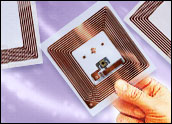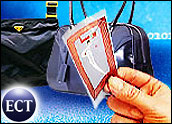
A recent Gartner report predicts a 50 percent failure rate for radio frequency identification projects implemented between now and the end of the year. However, those involved in industry alliances and manufacturer projects that pull together best-in-class vendors proclaim that RFID is more than a solution looking for a problem — it’s a significant improvement in tightening the supply chain and giving product manufacturers better communication with everyone from their materials suppliers to their customers.
Texas Instruments and BearingPoint recently announced an alliance in which they’ll sell TI’s RFID hardware along with advice on how to manage the data manufacturers gain through tagging their cases and pallets with radio-frequency devices.
“The TI/BearingPoint relationship can help with the failures Gartner predicts,” said John Cummings, managing director of BearingPoint’s supply practice. “The two organizations are very experienced in RFID.” He told CRM Buyer that TI likely has operated more RFID projects than any other vendor and has had notable successes, including the Mobil SpeedPass project.
Data Management
Along with a history of evolving expertise with the hardware, the new partnership contributes intellectual capital to the projects on which it works. “One of the factors that’s going to drive success vs. failure is how you manage the data,” Cummings said. “The great thing about RFID is it takes the human error out…. One of the big things, and frankly what we’re spending the majority of our time on is how various applications execute on this data.”
BearingPoint brings its lessons on system integration to the table. “With the experience in hardware that TI has and our experience in how we use data-rich environments, we think we can help companies better than most. As far as will 50 percent of them fail, we don’t know that. But if companies aren’t selecting the best vendors, they may run into that.”
Already a Convert
Jack Link’s Beef Jerky became an RFID convert after Wal-Mart ordered 100 of its suppliers tocomply with the retailer’s RFID program by January 2005. Jack Link’s was not among these 100, but the dried-meats provider sees no benefit in taking its time. Jack Link’s received word from Wal-Mart that it has until 2006 to get with the RFID program, but already it has spent $48,000 on Phase One of its RFID project, tagging cases and pallets of one of its products destined for Wal-Mart’s north Texas distribution center.
“What we’re hoping to do is get some of the hardware in and do our own testing rather than relying on others to test it, because what we’ve found is that the RFID equipment performs differently in different environments,” said Karl Paepke, vice president of operations at the company in Minog, Wisconsin.
Jack Link’s has cobbled together its own band of partners. Microsoft Business Solutions provides the middleware software that talks to the RFID system and Jack Link’s enterprise resource planning (ERP) system. ABC Computers is helping integrate the Microsoft piece with the RFID readers from SAMSys Technologies. Avery Dennison produces the RFID labels, and SATO America has responsibility for the printers of tags embedded with RFID transponders.
“Our biggest reluctance was in getting into RFID when there wasn’t a clear standard,” Paepke said. To minimize the risk, “We looked for the best in class in each area and for the flexibility of vendors — their ability to adapt to changes in technology in the future.”
Prior to the launch of Phase One, the company held three meetings attended by all of the chosen vendors at which the group “hammered out expectations,” he said. The group therapy has worked for Jack Link’s in ensuring smooth systems integration. “We’ve been very happy with their communication with us and with one another,” Paepke said of his company’s vendors.
Broader Objectives
RFID will help Jack Link’s internally, too, in tracking meat from its arrival at the factory, throughout its processing, to store shelves. The company plans to permanently tag steel tubs into which lots of meat will be placed. Upon completion of the raw material’s transformation into vacuum-packed meat strips, the tub will be recycled for infinite more trips through the manufacturing process. This is Jack Link’s Phases Two and Three. “We’ll use RFID as an automatic data collection system to track our manufacturing facility,” Paepke said.
He admitted that the company’s long-standing focus on investing solely in manufacturing improvements meant the neglect of the supply chain. “We may be a bit archaic in our supply chain,” he said. But Phases Two, Three and Four aim to offer complete visualization of the supply chain, from lot tracking of raw materials for FDA compliance in Phase Two — something now handled manually in a very tedious and inefficient process — to tags on tubs in Phase Three, to using RFID tags and readers to track the transfers of products moving from its manufacturing sites to its distribution center in Phase Four, planned for completion by the end of Q2 2005.
Paepke said the company’s projections show a with a positive return on the RFID investment 12 months later.
“We’re not just selling to Wal-Mart. We’re hoping to be compliant with the Department of Defense and Target mandates in the future as well.”
Show Me the Money
Jeff Woods, principal analyst for Gartner Group and author of “Prepare for Disillusionment with RFID” is not so sure RFID will provide the results vendors are seeking.
“Twenty years ago, bar codes generated so much data, and it was very difficult to justify the storage of data because companies hadn’t figured out how to use it,” he said. “With RFID, the data is manageable, but can people figure out how to use the data? And that’s a trick. Most people have figured out how to make RFID work but not how to make money on it.”
Compliance with the Wal-Marts and Targets and DODs of the world does not translate to a business case, no matter what vendors tell their RFID clients.
Woods predicts that partnerships such as the one between TI and BearingPoint aren’t going to yield much benefit for the partners or for customers. Woods told CRM Buyer, “There’s a level of scrutiny that’s not being applied.”












































